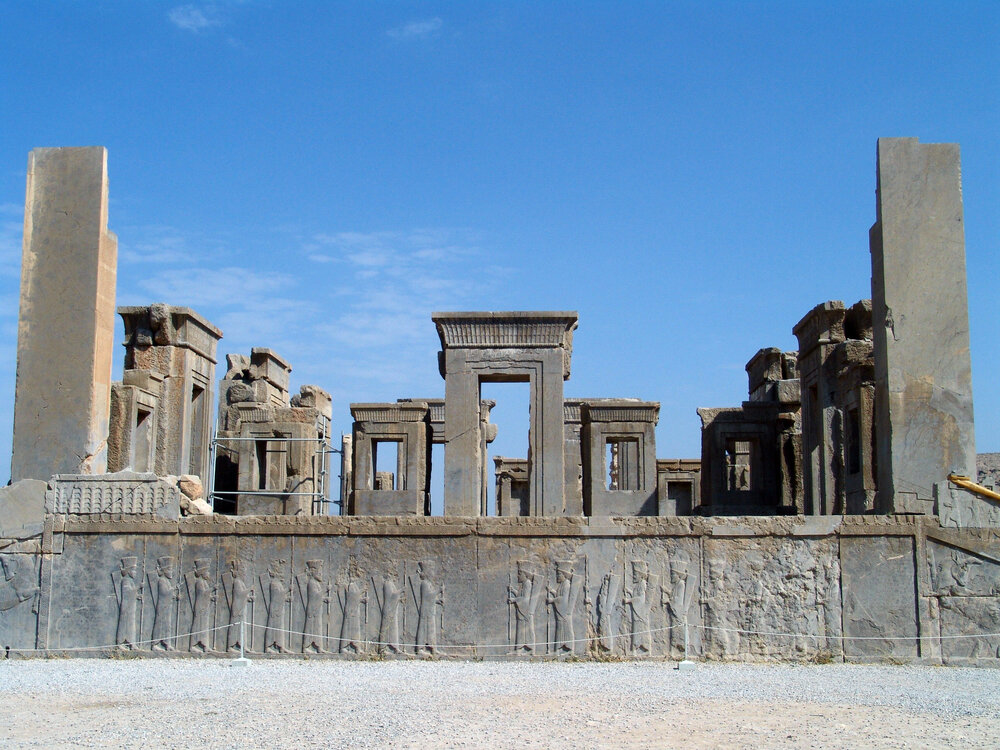Inscriptions in Persepolis palace hold clues about evolution of Persian script

TEHRAN – The ruined Tachara Palace, located in heart of the UNESCO-registered Persepolis, bears various inscriptions and bas-relief carvings, which according to experts hold clues about the evolution of the Persian script (and language).
Mojtaba Doroodi, who is a specialist in historical linguistics, etymology, and Iranian languages, believes the (modern) Persian language tightly follows Middle and Old Persian, whose inscriptions written in cuneiform exist in Tachara Palace, ILNA reported on Tuesday.
The bas-relief inscriptions are mainly associated with the Achaemenid kings Darius I (commonly known as Darius the Great), Xerxes, and Artaxerxes, Doroodi said.
Furthermore, the palace is home to inscriptions written in Middle Persian or Pahlavi script, which date from the reign of Shapur II (Shapur the Great), the researcher said.
Persian language, also called Farsi, is a member of the Iranian branch of the Indo-Iranian language family. Old Persian, spoken until approximately the 3rd century BC, is attested by numerous inscriptions written in cuneiform, most notable of which is the great monument of Darius I at Bisotun, western Iran.
Middle Persian, spoken from the 3rd century BC to the 9th century CE, is represented by numerous epigraphic texts of Sasanian kings, written in Aramaic script; there is also varied literature in Middle Persian embracing both the Zoroastrian and the Manichaean religious traditions. Pahlavi was the name of the official Middle Persian language of the Sassanian empire, according to Britannica.
Tachara is one of the oldest and most interesting palaces of Persepolis that its charming structure is situated south of the Apadana and on a platform 2.20-3m higher than the level of the latter and the adjacent courtyard.
Persepolis website says that Tachara was built on a rectangular plan, measuring 40m by 30m, and a north-south axis. It consists of the main hall with twelve columns, two smaller columned halls on the north, a columned portico on the south, and several guardrooms or storage chambers on either side. A stairway with two reversed flights leads to the portico from a courtyard on the south. The inner walls of these flights are sculptured with representations of servants and attendants, dressed alternately in the «Median» and «Persian» costumes, carrying food and utensils.
A frieze consisting of several scenes is sculptured on the center of the facade of the staircase. In the upper part of the middle section is the winged-circle (the Iranian Glory), flanked by two antithetic seated sphinxes who each raise a hand towards it in a gesture of veneration.
Behind each sphinx is a terrace of palm trees. Below this scene are two antithetic rows of nine soldiers in the «Persian» costume (fluted cylindrical tiaras, flowing skirts, and three-strapped shoes). They are facing a cuneiform inscription in Old Persian carved by Xerxes in a rectangular area framed by bands of rosettes.
The main hall and other rooms are provided with rectangular niches, each of which is hewn from a single block of stone and is crowned with a vertically fluted architrave element known as the Egyptian covetto cornice. Originally, five doors pierced the walls of the main hall: two opening into the pair of four-columned northern rooms, one giving access to the southern portico, and two leading into the adjacent western and eastern chambers.
Persepolis, also known as Takht-e Jamshid, whose magnificent ruins rest at the foot of Kuh-e Rahmat (Mountain of Mercy) is situated 60 kilometers northeast of the city of Shiraz in Fars province. The city was burnt by Alexander the Great in 330 BC apparently as revenge to the Persians because it seems Xerxes had burnt the Greek city of Athens around 150 years earlier.
AFM
Leave a Comment